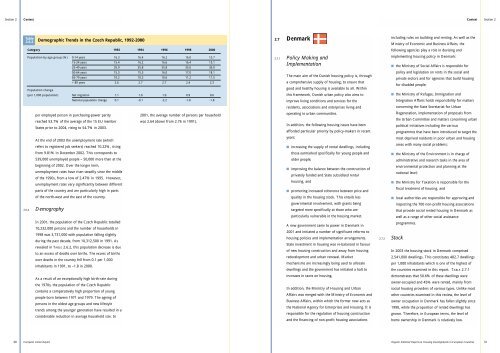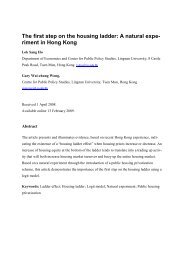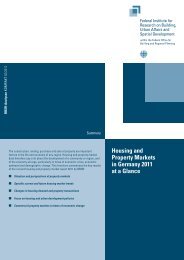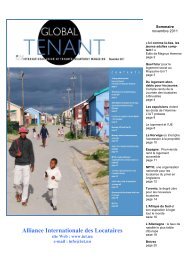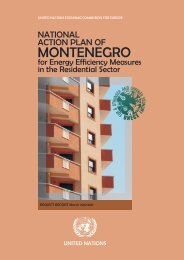housing developments in european countries - Department of ...
housing developments in european countries - Department of ...
housing developments in european countries - Department of ...
Create successful ePaper yourself
Turn your PDF publications into a flip-book with our unique Google optimized e-Paper software.
Section 2<br />
Context<br />
Context Section 2<br />
Table<br />
2.6.2<br />
Demographic Trends <strong>in</strong> the Czech Republic, 1992-2000<br />
Category 1992 1994 1996 1998 2000<br />
Population by age group (%) 0-14 years 16.3 16.4 16.2 16.0 15.7<br />
15-24 years 15.4 16.2 16.6 16.4 15.1<br />
25-49 years 35.9 35.8 35.8 35.6 36.0<br />
50-64 years 15.3 15.5 16.0 17.0 18.1<br />
65-79 years 10.2 10.3 10.6 11.2 11.5<br />
> 80 years 2.6 2.7 2.7 2.4 2.3<br />
Population change<br />
(per 1,000 population) Net migration 1.1 1.0 1.0 0.9 0.6<br />
National population change 0.1 -0.1 -2.2 -1.8 -1.8<br />
per employed person <strong>in</strong> purchas<strong>in</strong>g-power parity<br />
reached 53.7% <strong>of</strong> the average <strong>of</strong> the 15 EU member<br />
States prior to 2004, ris<strong>in</strong>g to 54.7% <strong>in</strong> 2003.<br />
At the end <strong>of</strong> 2003 the unemployment rate (which<br />
refers to registered job seekers) reached 10.22%, ris<strong>in</strong>g<br />
from 9.81% <strong>in</strong> December 2002. This corresponds to<br />
539,000 unemployed people – 50,000 more than at the<br />
beg<strong>in</strong>n<strong>in</strong>g <strong>of</strong> 2002. Over the longer term,<br />
unemployment rates have risen steadily s<strong>in</strong>ce the middle<br />
<strong>of</strong> the 1990s, from a low <strong>of</strong> 2.47% <strong>in</strong> 1995. However,<br />
unemployment rates vary significantly between different<br />
parts <strong>of</strong> the country and are particularly high <strong>in</strong> parts<br />
<strong>of</strong> the north-west and the east <strong>of</strong> the country.<br />
2.6.4 Demography<br />
In 2001, the population <strong>of</strong> the Czech Republic totalled<br />
10,232,000 persons and the number <strong>of</strong> households <strong>in</strong><br />
1998 was 3,731,000 with population fall<strong>in</strong>g slightly<br />
dur<strong>in</strong>g the past decade, from 10,312,500 <strong>in</strong> 1991. As<br />
revealed <strong>in</strong> TABLE 2.6.2, this population decrease is due<br />
to an excess <strong>of</strong> deaths over births. The excess <strong>of</strong> births<br />
over deaths <strong>in</strong> the country fell from 0.1 per 1,000<br />
<strong>in</strong>habitants <strong>in</strong> 1991, to –1.8 <strong>in</strong> 2000.<br />
As a result <strong>of</strong> an exceptionally high birth-rate dur<strong>in</strong>g<br />
the 1970s, the population <strong>of</strong> the Czech Republic<br />
conta<strong>in</strong>s a comparatively high proportion <strong>of</strong> young<br />
people born between 1971 and 1979. The age<strong>in</strong>g <strong>of</strong><br />
persons <strong>in</strong> the oldest age groups and new lifestyle<br />
trends among the younger generation have resulted <strong>in</strong> a<br />
considerable reduction <strong>in</strong> average household size. In<br />
2001, the average number <strong>of</strong> persons per household<br />
was 2.64 (down from 2.76 <strong>in</strong> 1991).<br />
2.7 Denmark<br />
2.7.1 Policy Mak<strong>in</strong>g and<br />
Implementation<br />
The ma<strong>in</strong> aim <strong>of</strong> the Danish <strong>hous<strong>in</strong>g</strong> policy is, through<br />
a comprehensive supply <strong>of</strong> <strong>hous<strong>in</strong>g</strong>, to ensure that<br />
good and healthy <strong>hous<strong>in</strong>g</strong> is available to all. With<strong>in</strong><br />
this framework, Danish urban policy also aims to<br />
improve liv<strong>in</strong>g conditions and services for the<br />
residents, associations and enterprises liv<strong>in</strong>g and<br />
operat<strong>in</strong>g <strong>in</strong> urban communities.<br />
In addition, the follow<strong>in</strong>g <strong>hous<strong>in</strong>g</strong> issues have been<br />
afforded particular priority by policy-makers <strong>in</strong> recent<br />
years:<br />
■ <strong>in</strong>creas<strong>in</strong>g the supply <strong>of</strong> rental dwell<strong>in</strong>gs, <strong>in</strong>clud<strong>in</strong>g<br />
those earmarked specifically for young people and<br />
older people;<br />
■ improv<strong>in</strong>g the balance between the construction <strong>of</strong><br />
privately funded and State subsidised rental<br />
<strong>hous<strong>in</strong>g</strong>, and<br />
■ promot<strong>in</strong>g <strong>in</strong>creased coherence between price and<br />
quality <strong>in</strong> the <strong>hous<strong>in</strong>g</strong> stock. This entails less<br />
governmental <strong>in</strong>volvement, with grants be<strong>in</strong>g<br />
targeted more specifically at those who are<br />
particularly vulnerable <strong>in</strong> the <strong>hous<strong>in</strong>g</strong> market.<br />
A new government came to power <strong>in</strong> Denmark <strong>in</strong><br />
2001 and <strong>in</strong>itiated a number <strong>of</strong> significant reforms to<br />
<strong>hous<strong>in</strong>g</strong> policies and implementation arrangements.<br />
State <strong>in</strong>vestment <strong>in</strong> <strong>hous<strong>in</strong>g</strong> was re-balanced <strong>in</strong> favour<br />
<strong>of</strong> new <strong>hous<strong>in</strong>g</strong> construction and away from <strong>hous<strong>in</strong>g</strong><br />
redevelopment and urban renewal. Market<br />
mechanisms are <strong>in</strong>creas<strong>in</strong>gly be<strong>in</strong>g used to allocate<br />
dwell<strong>in</strong>gs and the government has <strong>in</strong>itiated a halt to<br />
<strong>in</strong>creases <strong>in</strong> taxes on <strong>hous<strong>in</strong>g</strong>.<br />
In addition, the M<strong>in</strong>istry <strong>of</strong> Hous<strong>in</strong>g and Urban<br />
Affairs was merged with the M<strong>in</strong>istry <strong>of</strong> Economic and<br />
Bus<strong>in</strong>ess Affairs, with<strong>in</strong> which the former now acts as<br />
the National Agency for Enterprises and Hous<strong>in</strong>g. It is<br />
responsible for the regulation <strong>of</strong> <strong>hous<strong>in</strong>g</strong> construction<br />
and the f<strong>in</strong>anc<strong>in</strong>g <strong>of</strong> non-pr<strong>of</strong>it <strong>hous<strong>in</strong>g</strong> associations<br />
<strong>in</strong>clud<strong>in</strong>g rules on build<strong>in</strong>g and rent<strong>in</strong>g. As well as the<br />
M<strong>in</strong>istry <strong>of</strong> Economic and Bus<strong>in</strong>ess Affairs, the<br />
follow<strong>in</strong>g agencies play a role <strong>in</strong> devis<strong>in</strong>g and<br />
implement<strong>in</strong>g <strong>hous<strong>in</strong>g</strong> policy <strong>in</strong> Denmark:<br />
■ the M<strong>in</strong>istry <strong>of</strong> Social Affairs is responsible for<br />
policy and legislation on rents <strong>in</strong> the social and<br />
private sectors and for agencies that build <strong>hous<strong>in</strong>g</strong><br />
for disabled people;<br />
■ the M<strong>in</strong>istry <strong>of</strong> Refugee, Immigration and<br />
Integration Affairs holds responsibility for matters<br />
concern<strong>in</strong>g the State Secretariat for Urban<br />
Regeneration, implementation <strong>of</strong> proposals from<br />
the Urban Committee and matters concern<strong>in</strong>g urban<br />
political <strong>in</strong>itiatives <strong>in</strong>clud<strong>in</strong>g the various<br />
programmes that have been <strong>in</strong>troduced to target the<br />
most deprived residents <strong>in</strong> poor urban and <strong>hous<strong>in</strong>g</strong><br />
areas with many social problems;<br />
■ the M<strong>in</strong>istry <strong>of</strong> the Environment is <strong>in</strong> charge <strong>of</strong><br />
adm<strong>in</strong>istrative and research tasks <strong>in</strong> the area <strong>of</strong><br />
environmental protection and plann<strong>in</strong>g at the<br />
national level;<br />
■ the M<strong>in</strong>istry for Taxation is responsible for the<br />
fiscal treatment <strong>of</strong> <strong>hous<strong>in</strong>g</strong>, and<br />
■ local authorities are responsible for approv<strong>in</strong>g and<br />
<strong>in</strong>spect<strong>in</strong>g the 700 non-pr<strong>of</strong>it <strong>hous<strong>in</strong>g</strong> associations<br />
that provide social rented <strong>hous<strong>in</strong>g</strong> <strong>in</strong> Denmark as<br />
well as a range <strong>of</strong> other social assistance<br />
programmes.<br />
2.7.2 Stock<br />
In 2003 the <strong>hous<strong>in</strong>g</strong> stock <strong>in</strong> Denmark comprised<br />
2,541,000 dwell<strong>in</strong>gs. This constitutes 482.7 dwell<strong>in</strong>gs<br />
per 1,000 <strong>in</strong>habitants which is one <strong>of</strong> the highest <strong>of</strong><br />
the <strong>countries</strong> exam<strong>in</strong>ed <strong>in</strong> this report. TABLE 2.7.1<br />
demonstrates that 50.6% <strong>of</strong> these dwell<strong>in</strong>gs were<br />
owner-occupied and 45% were rented, ma<strong>in</strong>ly from<br />
social <strong>hous<strong>in</strong>g</strong> providers <strong>of</strong> various types. Unlike most<br />
other <strong>countries</strong> exam<strong>in</strong>ed <strong>in</strong> this review, the level <strong>of</strong><br />
owner occupation <strong>in</strong> Denmark has fallen slightly s<strong>in</strong>ce<br />
1990, while the proportion <strong>of</strong> rented dwell<strong>in</strong>gs has<br />
grown. Therefore, <strong>in</strong> European terms, the level <strong>of</strong><br />
home ownership <strong>in</strong> Denmark is relatively low.<br />
30 European Union Report<br />
Regular National Report on Hous<strong>in</strong>g Developments <strong>in</strong> European Countries<br />
31


